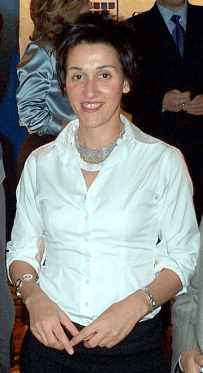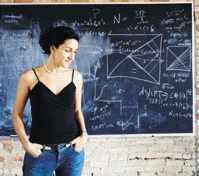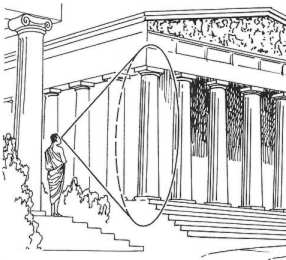.
Griechische Wissenschaftler

The development during the present century is characterized by two theoretical systems essentially independent of each other: the theory of relativity and the quantum theory. The two systems do not directly contradict each other; but they seem little adapted to fusion into one unified theory. For the time being we have to admit that we do not possess any general theoretical basis for physics which can be regarded as its logical foundation. If, then, it is true that the axiomatic basis of theoretical physics cannot be extracted from experience but must be freely invented, can we ever hope to find the right way? I answer without hesitation that there is, in my opinion, a right way, and that we are capable of finding it. I hold it true that pure thought can grasp reality, as the ancients dreamed. Albert Einstein, 1954
Fifty years passed since Einstein's remarks. Are we closer to this unification?
Fotini Markopoulou-Kalamara is one of the world's most promising young physicists. Fotini Markopoulou-Kalamara, was born in Greece and is an Adjunct Professor in the physics department at the University of Waterloo, Canada. Markopoulou-Kalamara is trying to unite Einstein's theory of general relativity with quantum theory, in an attempt to explain the nature of space and time. According to her “causal spin networks theory” the universe is like a giant quantum computer, and this could forever change the way we think about the structure of space. She, and others, attempt to make explicit some of the implicit mathematical assumptions underpinning modern theoretical physics and cosmology. Her foundational work in quantum physics has been compared to Cantor's foundational work on the theory of the continuum. Markopoulou-Kalamara was recognized for a new formulation of quantum cosmology in which quantum theory is applied to a system that contains its own observers, such as the whole universe. She has also explored the role of causality in the quantum theory of gravity and developed methods to study the relationship between the quantum and classical theories of gravity

In her paper "The Internal Description of a Causal Set: What the Universe Looks Like from the Inside" Fotini Markopoulou-Kalamara instantiates some abstract terms from mathematical category theory to develop straightforward models of space-time. It proposes simple quantum models of space-time based on category-theoretic notions of a topos and its subobject classifier (which has a Heyting algebra structure, but not necessarily a Boolean algebra structure). The diagrams in Markopoulou's papers are straightforward presentations of possible models of space-time. They are intended as meaningful and provocative, not just for specialists but also for newcomers.

From her page at the Perimeter Institute for Theoretical Physics :
"Fotini received her Ph.D. from Imperial College (1998). Dr. Markopoulou-Kalamara is a broadly talented researcher who recently shared First Prize in the Young Researchers competition at the Ultimate Reality Symposium in Princeton, New Jersey. Previous postdoctoral positions were held at the Albert Einstein Institute, Imperial College London, and Penn State University."
PRINCETON, NJ -- March 21, 2002: Two researchers have won an international competition for young physicists, sharing a $15,000 first prize, it was announced Thursday following the Science & Ultimate Reality symposium honoring one of America’s greatest living physicists, John Archibald Wheeler, now in his 91st year. Raphael Bousso, from the University of California, Santa Barbara and Fotini Markopoulou-Kalamara, from the University of Waterloo, Canada shared the top prize. They were among 15 finalists, ten men and five women, between the ages of 24 and 32, from eight countries. The Cosmology Prize of the Peter Gruber Foundation recognizes individuals who have contributed to the fundamental advances in the field of cosmology. The purpose of the Prize is to acknowledge and encourage further exploration in a field that shapes the way the universe is perceived and comprehended
I always thought that if we could look really close, space and space-time would turn out to be not smooth and geometrical, as in Einstein's theory, but 'bumpy' and made up of building blocks," said Dr. Fotini Markopoulou Kalamara. She is part of a group trying to show that space and time are built from mathematical units called spin nets. With a slightly different turn of fate she might not have gone into physics. As an undergraduate she spent a summer at a national physics laboratory in England: "My supervisor there told me many times that I should not go into particle physics, that the era of accelerators and great experiments was all over and it was a dying field," Dr. Markopoulou said. "In fact, he advised me to do biology, which he thought was the science of the future."
In loop quantum Gravity or LQG, reality is built of loops that interact and combine to form so-called spin networks-- first envisioned by English mathematician Roger Penrose in the 1960s as abstract graphs. Smolin and Rovelli used standard techniques to quantize the equations of general relativity and in doing so discovered Penrose's networks buried in the math. The nodes and edges of these graphs carry discrete units of area and volume, giving rise to three-dimensional quantum space. But because the theorists started with relativity, they were still left with some semblance of a space outside the quantum networks.
That was the state of LQG in the late 1990s, when Markopoulou Kalamara began tackling it. Markopoulou Kalamara approached LQG's extraneous space problem by asking, Why not start with Penrose's spin networks (which are not embedded in any preexisting space), mix in some of the results of LQG, and see what comes out? The result was networks that do not live in space and are not made of matter. Rather their very architecture gives rise to space and matter. In this picture, there are no things, only geometric relationships.
Now the idea is extended to space-time. Space ceases to be a place where objects such as particles bump and jitter and instead becomes a kaleidoscope of ever changing patterns and processes. Each spin network resembles a snapshot, a frozen moment in the universe. Off paper, the spin networks evolve and change based on simple mathematical rules and become bigger and more complex, eventually developing into the large-scale space we inhabit.
Markopoulou Kalamara can explain the structure of space-time. In particular, she argues that the abstract loops can produce one of the most distinctive features of Einstein's theory-- light cones, regions of space-time within which light, or anything else, can reach a particular event. Light cones ensure that cause precedes effect. We can understand this concept by gazing upward and knowing that there are countless stars we cannot see because not enough time has passed since the birth of the universe for their light to shine our way; they are beyond our light cone. It is not so obvious, though, where light cones fit into the spin networks. Those networks are subject to quantum mechanics. In that wonderland of uncertainty, any network has the potential to evolve into infinite new ones, leaving no trace of a causal history.

The ancient Greeks studied the geometric properties of light. According to a optics text book they considered only rays inside the cone of visibility. It is interesting that Kalamara considers now the “light cones” that includes also time.
"We didn't know how, in the language we were working in, to put in the notion of causality" in LQG, Smolin says. Markopoulou Kalamara found that by attaching light cones to the nodes of the networks, their evolution becomes finite and causal structure is preserved. But a spin network represents the entire universe, and that creates a big problem. According to the standard interpretation of quantum mechanics, things remain in a limbo of probability until an observer perceives them. But no lonely observer can find himself beyond the bounds of the universe staring back. How, then, can the universe exist?
"That's a whole sticky thing," Markopoulou Kalamara says. "Who looks at the universe?" For her, the answer is: we do. The universe contains its own observers on the inside, represented as nodes in the network. Her idea is that to paint the big picture, you don't need one painter; many will do. Specifically, she realized that the same light cones she had used to bring causal structure into quantum space-time could concretely define each observer's perspective. Because the speed of light is finite, you can see only a limited slice of the universe. Your position in space-time is unique, so your slice is slightly different from everyone else's. Although there is no external observer who has access to all the information out there, we can still construct a meaningful portrait of the universe based on the partial information we each receive. It's a beautiful thought: we each have our own universe. But there's a lot of overlap.
"We mostly see the same thing," Markopoulou Kalamara explains, and that is why we see a smooth universe despite a quantized space-time. "I actually think theoretical physics is very much like art," concludes Markopoulou Kalamara, the daughter of two sculptors. "Putting these things together is like taking clay and making something out of nothing, and it should work from every side. I like the creative part, but I also like that you can check."
Kalamara considers that space-time is not continuous but consists of irreducible pieces. Gamma ray bursts, gigantic explosions far away from us (hopefully!) that release extreme high energetic gamma rays may help in observing such a structure of space-time. The Gamma-ray Large Area Space Telescope will search when launched as expected in 2006 for such bursts. Analyzing these would help to find out if the structure of space can be seen in the photon spectra. The extreme energies and the huge distance the gamma rays have to travel to reach the detectors could produce effects that can be observed. These conditions are necessary in order to observe the extreme small structures of space-time as described by Kalamara. Individual photons should travel at slightly different speeds, depending on their wavelength. There are details to work out, such as how to derive the usual one-dimensional time from the quantum causality, but she figures that if observations can confirm the basics of spin networks, she'll smooth out the kinks.
References
http://www.ahepacanada.org/archives/hbot_2003gradawards.htm (Image of Kalamara)
- The Internal Description of a Causal Set: What the Universe Looks Like from the Inside: Full text (Adobe Acrobat PDF file, PS and other formats) can be downloaded from: http://xxx.lanl.gov/abs/gr-qc/9811053
- A Scientific American Story: http://www.sciam.com/article.cfm?articleID=0007E95C-9597-1DC9-
- Recent Conceptual Consequences of Loop Quantum Gravity, Part I: Foundational Aspects
- Recent Conceptual Consequences of Loop Quantum Gravity, Part II: Holistic Aspects
- Recent Conceptual Consequences of Loop Quantum Gravity. Part III: Postcript On Time
| Ancient Greece
Science, Technology , Medicine , Warfare, , Biographies , Life , Cities/Places/Maps , Arts , Literature , Philosophy ,Olympics, Mythology , History , Images Medieval Greece / Byzantine Empire Science, Technology, Arts, , Warfare , Literature, Biographies, Icons, History Modern Greece Cities, Islands, Regions, Fauna/Flora ,Biographies , History , Warfare, Science/Technology, Literature, Music , Arts , Film/Actors , Sport , Fashion --- |

